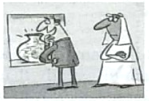-
Many people love travelling to different countries, but if you plan to go abroad, you should know how to behave properly in different situations around the world.
Most travelers enjoy meeting new people, but sometimes you can be rude without saying anything. In Russia, you should never shake hands in a doorway. And if you're travelling in Thailand, never touch people’s heads or point your feet at people. When the Japanese meet new people, they like giving business cards---but you should read the card carefully, not just put it in your pocket.
In most countries in Europe, people expect a lot of eye contact (交流) when you talk to them, but in many Asian countries, a lot of eye contact seems unfriendly. In South America, people usually stand quite close to each other when they talk, but in countries like the USA, you need to give people more personal space. Also, it's rude to interrupt(打断) Japanese people while they are talking to you. You must wait until they finish before you start speaking.
In restaurants in China, you can leave a bit of food on your plate, and it's OK to start smoking before other people finish eating, but you mustn't do these things in the UK. When in India, remember to eat with your right hand. Also avoid leaving empty bottles on the dinner table in Russia---that's bad luck.
With so much to think about, it's not surprising that many people prefer going on holiday in their own countries---or you might just decide to stay at home!
根据短文内容,判断下列句子正误。正确的用“A”表示,不正确的用“B”表示。
1.In Russia, you are not supposed to shake hands in a doorway or leave empty bottles on the dinner table.
2.In Thailand, you can touch people's heads or point your feet at people.
3.In most European countries, a lot of eye contact seems unfriendly when you talk to people.
4.In restaurants in UK, it's OK to leave a bit of food on your plate and start smoking before other people finish eating.
5.The passage tells us how to behave properly in different situations around the world.
九年级英语阅读判断困难题查看答案及解析
-
Many people love travelling to different countries, but if you plan to go abroad, you should know how to behave in different situations around the world.

Most travelers enjoy meeting new people, but sometimes you can be rude without saying anything. In Russia, you should never shake hands in a doorway, and if you're travelling in Thailand, never touch people's heads or point your feet at people. When the Japanese meet new people, they like giving business cards-but you should read the card carefully, not just put it in your pocket。

In most countries in Europe people expect a lot of eye contact when you talk to them, but in many Asian countries a lot of eye contact seems unfriendly. And in South America people usually stand quite close to each other when they talk, but in countries like the USA you need to give people more personal space. Also, it's rude to interrupt Japanese people while they are talking to you. You must wait until they finish before you start speaking.

In restaurants in China you can leave a bit of food on your plate, it's OK to start smoking before other people finish eating, which you mustn't do in the UK. When in India, remember to eat with your right hand. Also avoid leaving empty bottles on the dinner table in Russia--that's bad luck.

When you're travelling in Asia, if someone invites you to his or her home, don' t forget to take off your shoes when you arrive. And if you visit an Arab family's home, don't admire anything valuable because your host will feel he should give it to you as a present.
With so much to think about, it's not surprising that many people prefer going on holiday in their own countries- or you might just decide to stay at home.
1.Which of the following statements is TRUE?
A. We can admire anything valuable in an Arab family's home.
B. In China,people cannot smoke before other people finish eating.
C. In Russia,it's impolite to shake hands with people in a doorway.
2.What does the underlined word"interrupt"mean in Chinese?
A. 跟随 B. 打断 C. 附和
3.What is the correct order of the subheadings( 小标题)from Paragraph 2 to Paragraph 5?
①Eating out ②In the home
③Body language ④Face-to-face communication
A. ②③④① B. ④①②③ C. ③④①②
4.What does the writer want to tell us?
A. Practice makes perfect.
B. Where there is a will, there is a way.
C. When in Rome, do as the Romans do.
5.What is the best title for the passage?
A. Culture Shock B. Table Manners C. Public Rules
九年级英语阅读单选困难题查看答案及解析
-
任务型阅读
Nowadays, Chinese people love to travel to foreign countries. Some people may say they can do everything they want because they spend money in the country. In fact, this is not true. Besides enjoying ourselves, we should respect local customs and care for the environment. How to be a good tourist when traveling abroad? Let’s take a look!
◆ It’s impolite to talk loudly in public places like coffee shops and museums.
◆ It is good manners to give tips (小费) when you travel in most Western countries.
◆ Don’t spit or litter. Stop yourself from writing or drawing on famous buildings.
◆ You shouldn’t take your shoes off when taking a plane.
◆ It isn’t good to change seats while the plane is taking off. Also it’s not good to reach for your luggage (行李) while the plane is landing.
◆ You mustn’t cross the road before the traffic lights are green.
◆ In a self-service restaurant, don’t take too much food. Wasting food is not a good idea.
根据短文内容,完成表格。
Bad manners(不良行为)that we should avoid when traveling abroad
Talking 1. in public.
Refusing to give tips.
Spitting and littering everywhere. Writing or drawing on ____2.______
_____3.____ your shoes during a flight.
Changing seats while the plane is taking off and getting luggage while the plane is landing.
Crossing the road when the traffic lights are still(仍然) 4. .
Taking too much food than you need in____5._________
九年级英语其他题中等难度题查看答案及解析
-
People visit other countries for many purposes. Some travel on businesses; others travel to visit interesting places that are only found in other countries.
Wherever you go, and for whatever purpose, it’s important to be safe. A tourist can attract a lot of attention from local people. While most people you meet when travelling are sure to be nice, there are dangers—theft being the most common. So prepare for your trip in advance.
As you prepare for your trip, make sure you have the right paperwork. You don’t want to get to your destination (目的地)only to find you have the wrong visa, or worse, that your passport is about to expire (到期). Also, make sure you travel with proper medical insurance, so that if you are sick or injured during your travels, you can be treated. If you want to drive while you are abroad, make sure you have an international driver’s license.
If you need to take medicine with you—such as travel-sickness pills—keep it in its original container(容器). If you don’t, you may find yourself doing a lot of explaining to customs officials at your destination.
Buy a guidebook and read about the local customs of the country you are going to. Also, try and learn a few basic words and phrases—don’t assume that the local people will speak your language.
When you get to your destination, you’d better use official transport. Always go to the bus and taxi stands, don’t accept rides from strangers who offer you a lift. If there is no meter in the taxi, agree on a price before you get in. If you prefer to stay in cheap hotels while travelling, make sure you can lock the door of your room from the inside. If you are travelling with valuables such as jewelry, or a lot of money, you should ask about a safe for storing them in. Finally, remember to smile. It’s the friendliest and most sincere form of communication, and is sure to be understood in any part of the world!
Have a Safe Trip
Aspects(方面) of being safe
1. on safety.
Paperwork
visa
You must have the 2. visa.
medical insurance
You are able to get 3. if you’re ill during the journey.
driving license
You should have the 4. driver’s license if you’d like to drive in foreign countries.
Medicine
Make sure it is 5. in its original containers.
Guidebook
If you buy one, you’ll know the local customs by 6. it.
7.
You can try to learn some simple words and phrases the local people use.
Transport
Use public transport. Don’t 8. into strangers’ cars.
Hotel
Lock the door from the 9..
Form of communication
Don’t forget to 10. when communicating with others.
九年级英语填空中等难度题查看答案及解析
-
It is exciting to travel to other countries. We can see many interesting things and people there. We can also _____ many delicious food there. But sometimes we aren't so happy _____ we can't understand the people there and it brings us much _____ .
One of the best ways of understanding the people is to watch _____ they do in their free time. Most English men, women and children love _____ things, especially flowers. Visitors _____ England in spring, summer or autumn _____ see gardens all the way along the railway lines. There are flowers at the airports, in factory grounds and in gardens along the roads. Each English town has _____ one park with beautiful flower beds. Public(公共的)buildings of every kind have beautiful window boxes and sometimes baskets of flowers are hanging(悬挂)outside.
But what the English enjoy most is growing things _____ . If it is impossible to have a garden, then a window box or a pot will do. Looking at each other's ______ is what the English like doing in their free time.
So when you travel to Britain, you can see the gardens to understand British people.
1.A.see B.buy C.taste D.get
2.A.though B.so C.before D.because
3.A.happiness B.sadness C.trouble D.worry
4.A.what B.how C.when D.which
5.A.watching B.buying C.enjoying D.growing
6.A.from B.to C.of D.in
7.A.should B.must C.can D.have to
8.A.at most B.at least C.only D.just
9.A.itself B.themselves C.himself D.herself
10.A.gardens B.kitchens C.schools D.bedrooms
九年级英语完型填空困难题查看答案及解析
-

Many people like travelling in mountains now. But what can we do if there is a sudden rain or even a storm? We need to be prepared and keep ourselves safe.
Put on any gear (护具) that you’ve brought
All hikers should carry lightweight rain gear or at least a raincoat in case of rain.
Keep your body moving
Move around as you wait so that your body stays warm. For example, step side to side.
Find a shelter
Look around for a place to get out of the rain, such as a tree, a cave even your tent. If you hear thunder, find an immediate shelter. Staying outside during a thunder storm is dangerous.
Watch for changes in the terrain (地形)
Rain can cause flooding, mud slides, rock slides and slippery trails (湿滑的山道), all of which can be very dangerous.
If you are in a lightning storm, the most dangerous places include open areas, hills, mountains, trees and waterways. Lightning is most likely to hit these areas. If you’re in the woods, try to find a small tree that is surrounded (环绕) by other taller trees. Hide yourself in the lowest place you can find.
Put down your trekking poles (登山杆) or other long things. In a lightning storm, trekking poles and long, pointy things make a great conductor for the lightning and are therefore very dangerous. Protect yourself by laying these items on the ground away from you.
Ways to keep 1. in a sudden mountain rain
When it’s rainy or stormy
●Put on the gear if you 2. one. It is suggested that a hiker should carry lightweight rain gear.
●Keep moving to make yourselves 3..
●Find a safe place to get out of the rain. It’s in 4. to stay outside.
●Be 5.! The rain may make some places dangerous.
When there’s a 6.
●We can’t stay in many places, 7. open areas, hills, mountains trees and waterways.
●A small tree with other taller trees 8. is good. The place for hide should be 9..
●Don’t 10. any long and pointy things.
九年级英语填空中等难度题查看答案及解析
-
1.More and ___people like to travel around the country with their families. (many)
2.The mother stopped her son from______games on the mobile phone. (play)
3.Could you please tell us about the four______of China? (invent)
4.The difficulties will become weaker as long as you face them______enough. (brave)
5.—May I borrow your pen? ______is left at home. (I)
—Sure. Here you are.
九年级英语语法填空困难题查看答案及解析
-
Many people travel to different places in the world by air. Usually it takes a long time, perhaps half a day, for passengers to stay in the plane. So airlines offer passengers food. But it is common that they feel bad about food taste. Do you agree?
To solve this problem , airlines try hard to improve their food. They would like to do so because they don’t want to lose customers.
However, according to scientific research, part of the reason why plane food tastes bad is that at high altitude( 海拔 )we can not taste things as well as we do on the ground. Also scientists have found that our noses become very dry even before a plane takes off. As the plane moves up, the change in air pressure( 气压 ) reduces one third of the sensibility(感觉 )of our taste buds( 味蕾 ).So our taste buds become senseless. The sad face, however, is that our noses don’t know it.
All of these help explain why food on the plane tastes so bad. They also help explain why airlines choose to offer passengers salty and spicy( 辛辣 )food. Without doing so, the food would be tasteless.
Now there are many researches on this. According to one of them, some volunteers are asked to lie with their feet higher than their heads for weeks. And scientists write down their feelings about food taste.
Though scientists try their best, it is not as easy as they thought. Because they can’t deal with the special environment successfully, such as the change in air pressure, making food taste good is still hard for them.
1.In Paragraph2,“this problem” means _______.
A. passengers stay long in the plane
B. food on the plane tastes bad
C. passengers have no food to eat
D. food on the plane is expensive
2.Why do scientists feel it hard to made food on the plane taste good?
A. The volunteers don’t know about food taste.
B. The volunteers don’t understand them.
C. They can’t find enough volunteers.
D. They can’t deal with the special environment successfully.
3.What is the best title of the passage?
A. Taste of Airplane Food
B. Airplane Travel
C. Scientific Research on Noses
D. The Change in Air Pressure.
九年级英语阅读单选中等难度题查看答案及解析
-
Many people travel to different places in the world by air. Usually it takes a long time, perhaps half a day, for passengers to stay in the plan. So airlines(航空公司)offer passengers food. But it is common that they feel bad about food taste. Do you agree?
To solve this problem, airlines try hard to improve their food. They would like to do so because they don’t want to lose customers.
However, according to scientific research, part of the reason why plane food tastes bad is that at high altitude(海拔)we can not taste things as well as we do on the ground. Also scientists have found that our noses become very dry even before a plane takes off. As the plane moves up, the change in air pressure(气压)reduces one third of the sensibility(感觉)of our taste buds(味蕾). So our taste buds become senseless. The sad face, however, is that our noses don’t know it.
All of these help explain why food on the plane tastes so bad. They also help explain why airlines choose to offer passengers salty and spicy(辛辣的)food. Without doing so, the food would be tasteless.
Now there are many researches on this. According to one of them, some volunteers are asked to lie with their feet higher than their heads for weeks. And scientists write down their feelings about food taste.
Though scientists try their best, it is not as easy as they thought. Because they can’t deal with the special environment successfully, such as the change in air pressure, making food taste good is still hard for them.
1.In Paragraph 2, “this problem” means ______.
A.passengers stay long in the plane
B.food on the plane tastes bad
C.passengers have no food to eat
D.food on the plane is expensive
2.What do airlines do to solve this problem?
A.Get more customers. B.Offer more food.
C.Improve their food. D.Reduce the ticket price.
3.As the plane moves up, the change in air pressure reduces of the sensibility of our taste buds.
A.half B.one third
C.one fourth D.one fifth
4.Why do scientists feel it hard to made food on the plane taste good?
A.The volunteers don’t know about food taste.
B.The volunteers don’t understand them.
C.They can’t find enough volunteers.
D.They can’t deal with the special environment successfully.
5.What is the best title of the passage?
A.Taste of Airplane Food
B.Airplane Travel
C.Scientific Research on Noses
D.The Change in Air Pressure
九年级英语阅读单选中等难度题查看答案及解析
-
Many people travel to different places in the world by air. Usually it takes a long time, perhaps half a day, for passengers to stay in the plane for a long time. So airlines offer passengers food. But it is common that they feel bad about food taste. Some passengers complain about the food to the airline companies , and some others even refuse to eat them. Do you agree?
To solve this problem, airlines try hard to improve their food. They would like to do so because they don’t want to lose customers.
However, according to scientific research, part of the reason why plane food tastes bad is that at high altitude we can not taste things as well as we do on the ground. Also scientists have found that our noses become very dry even before a plane takes off. As the plane moves up, the change in air pressure reduces one third of the sensibility of our taste buds(味蕾). So our taste buds become senseless (没有知觉的). The sad fact, however, is that our noses don’t know it.
All of these help explain why food on the plane tastes so bad. They also help explain why airlines choose to offer passengers salty and spicy food. Without doing so, the food would be tasteless.
Now there are many researches on this. According to one of them, some volunteers are asked to lie with their feet higher than their heads for weeks. And scientists write down their feelings about food taste.
Though scientists try their best, it is not as easy as they thought. Because they can’t deal with the special environment successfully, such as the change in air pressure, making food taste good is still hard for them.
1.In Paragraph 1, “complain” means ________________ in Chinese.
A.接受 B.投诉 C.讨厌 D.丢弃
2.What do airlines do to solve this problem ?
A.Get more customers. B.Offer more food.
C.Improve their food. D.Reduce the ticket price.
3.Our taste buds become senseless because of the following facts EXCEPT____________.
A.a high altitude B.the change in air pressure
C.our noses become dry D.the food goes bad in high altitude
4.Which of the following is True according to the passage?
A.Scientists have found a way to improve the plane food easily.
B.Airlines offer passengers salty and spicy food to save money
C.In the researches, some volunteers lie with their heads higher than their feet for weeks.
D.Though scientists try hard, they still can’t deal with the change in air pressure successfully.
5.What is the best title of the passage?
A.Taste of Airplane Food B.Airplane Food
C.Scientific Research on Food D.Our Taste Buds in High Altitude
九年级英语阅读单选中等难度题查看答案及解析